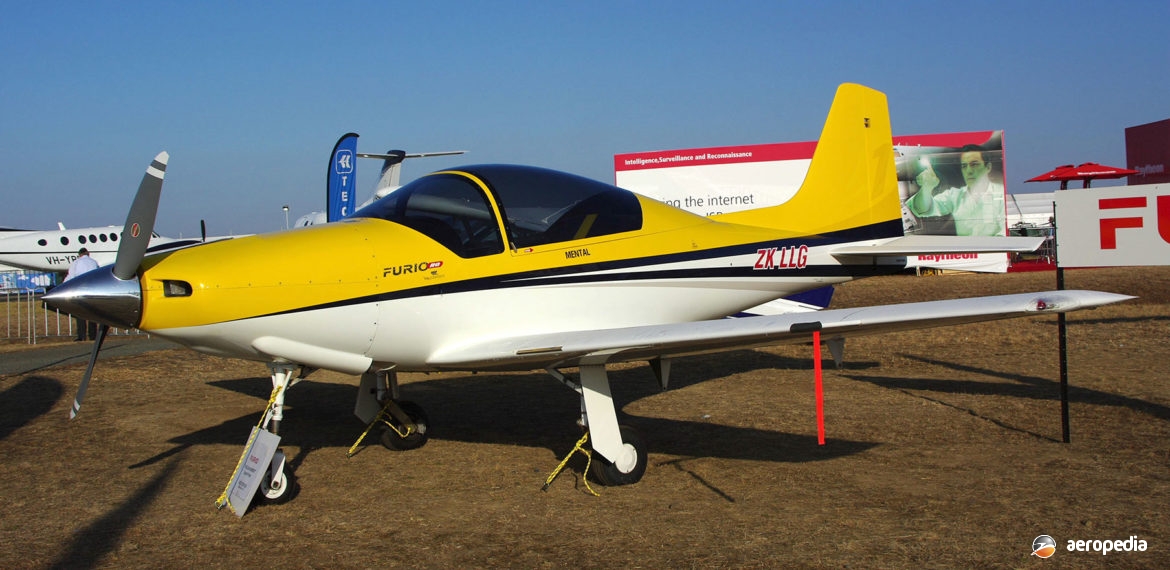Photograph:
Falcomposite LN-27RG Furio ZK-LLG (c/n 001) at the Australian International Air Show at Avalon, VIC in March 2011 (David C Eyre)
Country of origin:
New Zealand
Description:
Two-seat light sport monoplane
Power Plant:
One 134 kw (180 hp) Textron Lycoming Y-IO-360 four-cylinder horizontally-opposed air-cooled engine
Specifications:
- Wingspan: 8.02 m (26 ft 4 in)
- Length: 6.8 m (22 ft 4 in)
- Height: 2.4 m (7 ft 10 in)
- Wing area: 10.2 m² (110 sq ft)
- Performance with retractable undercarriage
- Max speed: 352 km/h (218 mph)
- Cruising speed at 75% power at 2,133 m (7,000 ft): 324 km/h (201 mph)
- Stalling speed [clean]: 109 km/h (68 mph)
- Stalling speed: [full flap]: 93 km/h (58 mph)
- Rate of climb: 610 m/min (2,000 ft/min)
- Range at 65% power at 2,743 m (9,000 ft): 1,389 km (863 miles)
- Take-off run over a 15 m (50 ft) obstacle: 350 m (1,148 ft)
- Landing run over a 15 m (50 ft) obstacle: 350 m (1,148 ft)
- Empty weight: 580 kg (1,279 lb)
- Useful load: 400 kg (882 lb)
- Max aerobatic weight: 792 kg (1,745 lb)
- Loaded weight [utility]: 980 kg (2,160 lb)
History:
The Falcomposite Furio was a two-seat light aircraft designed and developed by Giovani and Lapo Nustrini, Lapo Ancillotti, and Kevin Grant in Auckland, New Zealand, design of the aircraft commencing in about 2004, construction of the prototype beginning in early 2006. The Company’s plans were to have the prototype completed and flying in 2007. The design was similar in appearance to the Frati Falco and Sequoia Falco and used modern composite construction.
Designed to be fully aerobatic, it was made available in “Quick kit” form and was described as being “one of the most advanced kits available anywhere, and has been designed using the same principles as Boeing’s 777, the entire aircraft and its components being assembled and flown via virtual-reality form in a computer”. The manufacturer stated, because of the cost of certification, the aircraft would only be available in kit form. The aircraft kit comprised fewer than 30 structural components, a design goal being to make the aircraft as simple and straight-forward as possible to assemble. No jigs were required and features like a unique “belly lid” allowed builders access to the aircraft interior during construction. Cabin width was 1.1 m (36 in).
A number of power plants were considered for installation, including the 134 kw (180 hp) Lycoming IO-360 engine and the new Lycoming IO-390 engine also from the Lycoming stable, and the airframe was designed to take engines up to 194 kw (260 hp). It was expected eventually consideration would be given to one of the new breed of diesel engines, particularly those from Thielert.
The Furio was designed to operate from a variety of airfields, including grass strips of 500 m (1,640 ft) in length. It could be fitted with a fixed or a retractable tricycle undercarriage. The fixed undercarriage variant had a max speed of 330 km/h (205 mph), a similar cruising speed at 75 per cent power and a similar range.
The prototype was completed late in 2007 at the Company’s facility after a mock-up of the fuselage had been completed. The prototype was fitted with a new XP-IO-360 Lycoming engine, and the Company decided that production aircraft would be fitted with the 134 kw (180 hp) Lycoming Y-IO-360 as standard.
First flight of the prototype ZK-LLG (c/n 001) was made at Ardmore on 6 February 2008, the first kit-built aircraft delivered becoming ZK-NJS (c/n 002) to its owner in Dunedin a few months later, this aircraft having a retractable undercarriage. Further examples have been registered as ZK-RNA, ZK-NJS, ZK-SMR and ZK-WBW. First Furio completed in the United States was N861SA first flown in May 2012.
A Furio was placed on display at the Experimental Aircraft Association (EAA) event at Oshkosh in Wisconsin in July 2009, the aircraft to be fitted with a Lycoming IO-390 engine. The first kit-built Furio constructed in the United States was placed on display at the EAA event at Oshkosh in 2012. At that time 12 kits had been delivered to customers and a further five were sold to builders at Oshkosh that year.
First aircraft registered in Australia became VH-FUY³ (c/n 004) to its owner Leslie Elliott of Macedon, VIC on 12 April 2017, this aircraft having a retractable undercarriage and being powerd by an Aero Sport Power IO-375 engine driving an MT propeller.
In November 2015 a British company, Central Electric Propulsion (CEP), announced it was developing an electrically-powered variant of the Furio kitplane fitted with two 112 kw (150 hp) Independent Electric Motors driving twin contra-rotating propellers and plans were in place to complete the first aircraft by late 2016, the prototype to be completed by Potenza Ltd based in Coventry, the propellers to be provided by Hercules Propellers. A test vehicle with full CRPS was built to test the engines and comparisons were made with a Falcomposite Furio fitted with a Lycoming IO-360 engine driving a three-blade variable pitch propeller with a take-off weight of 1,200 kg (2,646 lb).

